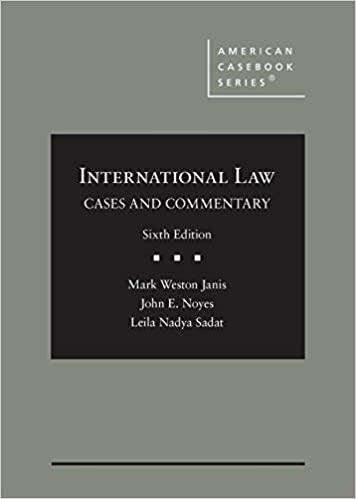Question
Question 1 (1 point) The UCC's rules regarding damages include all of the following except: Question 1 options: a) that the measure is the difference
Question 1 (1 point)
The UCC's rules regarding damages include all of the following
except:
Question 1 options:
a) that the measure is the difference between the value of the goods accepted and the value they would have had if they had been as warranted.
b) the remedies for material misrepresentation or fraud will be the same as for breach of contract.
c) That the measure of damages in cases of breach by anticipatory repudiation cannot be determined until the time for performance has passed.
d) that the UCC expressly permits the parties to limit or exclude consequential damages by agreement unless the limitation or exclusion is unconscionable.
Question 2 (1 point)
In which one of the following cases did the court rely in part on the rule that the measure of recovery by a wrongfully discharged employee is the amount of salary agreed upon for the period of service, less the amount which the employer proves the employee has earned or with reasonable effort might have earned from other employment?
Question 2 options:
a) Jacob & Youngs v. Kent.
b) Peevyhouse v. Garland Coal & Mining Company.
c) In re Worldcom, Inc.
d) Parker v. Twentieth Century-Fox Film Corp. Question 3 (1 point)
Which of the following statements is not correct regarding a seller's damages?
Question 3 options:
a) If the buyer's breach leaves the goods in the seller's possession or control, the seller may identify the goods to the contract and resell them at a private or public sale.
b) Agreements rarely provide an exclusive or limited remedy.
c) The seller's general damages for non-acceptance or repudiation by the buyer is the difference between the market price and the unpaid contract price.
d) Market price is generally the price at the time and place for tender.
Question 4 (1 point)
In which one of the following cases did the court explain the method for computing damages in construction cases, including the way that part payments are addressed in determining damages?
Question 4 options:
a) Jacob & Youngs v. Kent.
b) Peevyhouse v. Garland Coal & Mining Company.
c) In re Worldcom, Inc.
d) Parker v. Twentieth Century-Fox Film Corp.
Question 5 (1 point)
All of the following statements are correct statements regarding
a seller's consequential and incidental damages except: Question 5 options:
a) when payment is to be made to a third person, the creditor has not been allowed to recover special damages suffered.
b) none of the provisions of the UCC dealing with a seller's damages allow for the recovery of consequential damages.
c) incidental damages are recoverable whether the seller sues for damages following resale, for damages without reference to resale, or for the price.
d) the UCC expressly permits recovery for incidental damages.
Question 6 (1 point)
That damages are limited to the value of the performance sought, that is, the damages awarded in a breach of contract action cannot exceed the value of the breaching party's performance, is the key takeaway from:
Question 6 options:
a) Jacob & Youngs v. Kent.
b) Peevyhouse v. Garland Coal & Mining Company.
c) In re Worldcom, Inc.
d) Parker v. Twentieth Century-Fox Film Corp.
Question 7 (1 point)
Which one of the following statements is not correct regarding the wrongful discharge of an employee?
Question 7 options:
a) Special damages are rarely awarded for wrongful discharge.
b) Expenses incurred in an attempt to mitigate damages by securing other employment are recoverable.
c) Damages for injury to the employee's reputation are ordinarily said to be too remote and not in the contemplation of the parties.
d) Generally, a public officer's right to compensation is dependent on contract law.
Question 8 (1 point) The buyer's losses are:
Question 8 options:
a) ordinarily addressed by the rules of general damages, that is, the standard measure of damages.
b) limited to those that were foreseeable to the breaching seller.
c) limited to lost profits.
d) A and B.
Question 9 (1 point)
The case that addresses lost volume profits and shows the thresholds for the applicability of damages due to a seller's status as a lost volume seller is:
Question 9 options:
a) Jacob & Youngs v. Kent.
b) Peevyhouse v. Garland Coal & Mining Company.
c) In re Worldcom, Inc.
d) Parker v. Twentieth Century-Fox Film Corp.
Question 10 (1 point)
When a buyer breaches, the seller:
Question 10 options:
b) will be required to pay to the buyer any profits made on the resale.
c) has an exclusive remedy in reselling the goods.
d) B and C.
a) will be able to recover the difference between the resale price and the contract price.
Step by Step Solution
There are 3 Steps involved in it
Step: 1

Get Instant Access to Expert-Tailored Solutions
See step-by-step solutions with expert insights and AI powered tools for academic success
Step: 2

Step: 3

Ace Your Homework with AI
Get the answers you need in no time with our AI-driven, step-by-step assistance
Get Started


